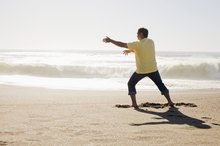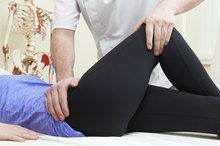What does fact checked mean?
At Healthfully, we strive to deliver objective content that is accurate and up-to-date. Our team periodically reviews articles in order to ensure content quality. The sources cited below consist of evidence from peer-reviewed journals, prominent medical organizations, academic associations, and government data.
The information contained on this site is for informational purposes only, and should not be used as a substitute for the advice of a professional health care provider. Please check with the appropriate physician regarding health questions and concerns. Although we strive to deliver accurate and up-to-date information, no guarantee to that effect is made.
If you have experienced a sharp, shooting pain in the lower back and down the back or side of the leg, you may have had sciatica 4. Certain activities and postures can trigger or aggravate sciatica. Cycling is a sport that often requires intense activity while hunched over and seated for long periods of time. This position can eventually lead to back problems and sometimes, sciatica pain 4.
Sciatica
**According to Mayoclinic.com, sciatica is a symptom, not a disorder.
It stems from pain of the sciatic nerve, which is the longest nerve in the body.
** The nerve begins at your spinal cord and runs through the buttock and down the back of each leg, providing feeling to your thighs, legs and feet.
Sciatic pain can stem from many different causes, such as a herniated disc in the spine, trauma, or piriformis syndrome, states the website.
The piriformis muscle is located deep within the other gluteal muscles, attaching to the sacrum and the thigh bone. It works to rotate the leg outward.
- According to Mayoclinic.com, sciatica is a symptom, not a disorder.
- It stems from pain of the sciatic nerve, which is the longest nerve in the body.
Symptoms of Sciatica
Pilates for Piriformis and the Gluteus Medius
Learn More
Mayoclinic.com lists radiating pain from your lower spine to your buttock and down the back of your leg as the "hallmark" sign of sciatica 4. The site states that the pain can vary, from dull or mild to sharp and shooting. You may also experience electric-like pain that is sudden and fleeting or a burning sensation. There may be numbness or tingling along the pathway of the nerve, as well as some loss of muscle strength.
The website also states that in some rare and severe cases, you can experience a loss of bowel or bladder control. This particular case is a sign of a more serious disorder, and you should seek medical help immediately.
- Mayoclinic.com lists radiating pain from your lower spine to your buttock and down the back of your leg as the "hallmark" sign of sciatica 4.
- The site states that the pain can vary, from dull or mild to sharp and shooting.
Cycling and Sciatica
When you ride a bike, you are putting pressure on your spine, your gluteal muscles, the coccyx, or tailbone, and your sciatic nerve. The seat is often small, possibly causing further compression of the muscles and nerves. Sciatica-pain.org states that some people have an unusual positioning of the sciatic nerve; it may run inside the piriformis muscle rather than beneath it 4. In this case, the nerve can become pinched more easily.
Further aggravation of your back muscles and spine can come from the “hunched” posture you typically assume while riding a road bike. Add to this position the vigorous use of your legs and you have a recipe for pressure and tension of the low back.
- When you ride a bike, you are putting pressure on your spine, your gluteal muscles, the coccyx, or tailbone, and your sciatic nerve.
- Further aggravation of your back muscles and spine can come from the “hunched” posture you typically assume while riding a road bike.
Emotional Contributions
Tai Chi Exercises for the Sciatica Nerve in the Back
Learn More
Because the symptoms manifest physically, you may not associate your mental state to the symptoms of sciatica 3. However, your stress levels and potential desire for perfection can also contribute, states sciatica-pain.org 4. Stress can increase tension in muscles of the neck and back, further contributing to the pressure in your spine and surrounding muscles and nerves. If you are a professional or serious cyclist, you are also typically focusing on your performance level. This focus and desire to achieve results adds to the amount of tension in your back and legs, leading to greater potential for pinching that sciatic nerve.
- Because the symptoms manifest physically, you may not associate your mental state to the symptoms of sciatica 3.
- This focus and desire to achieve results adds to the amount of tension in your back and legs, leading to greater potential for pinching that sciatic nerve.
Solutions and Treatments
According to Mayoclinic.com, most cases of sciatica respond well to self-care. Rest, alternating heat and cold packs, stretching, and over-the-counter pain medications may all be effective for your sciatic pain. Also, research other types of bike seats. You may need to change the type, states sciatic-pain.org, or adjust the height or tilt of the seat. Also consider your posture while on the bike. If hunching over the handlebars is aggravating, try a different style of bike. Take a trip to your local bike shop to check the fit of your bike and explore other options. If all self-care measures fail, talk to your doctor about your symptoms.
- According to Mayoclinic.com, most cases of sciatica respond well to self-care.
- You may need to change the type, states sciatic-pain.org, or adjust the height or tilt of the seat.
Related Articles
References
Writer Bio
Christy Callahan has been researching and writing in the integrative health care field for over five years, focusing on neuro-endocrinology. She has a Bachelor of Science degree in biology, earned credits toward a licensure in traditional Chinese medicine and is a certified Pilates and sport yoga instructor.









